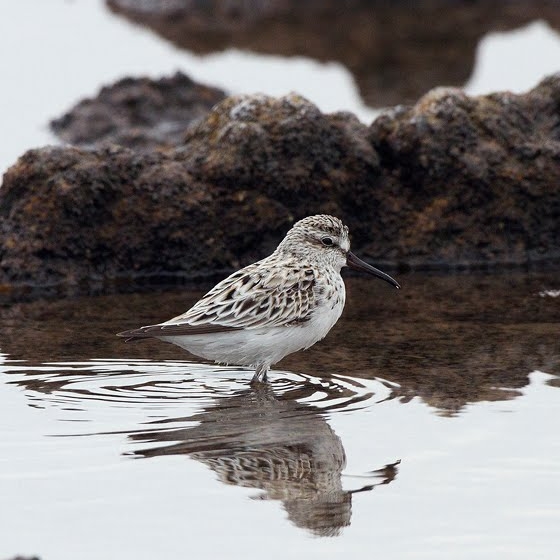Broad-billed Sandpiper

Introduction
Slightly smaller than a Dunlin with a distinctive eye stripe, the Broad-billed Sandpiper breeds in the upland bogs of Scandinavia and migrates to east Africa. A rare but regular vagrant to our shores.

Key Stats
Status and Trends
Conservation Status
Population Size
Population Change
Population trends of this scarce species are not routinely monitored.
Distribution
This species is a rare vagrant and was recorded during Bird Atlas 2007–11 as shown on the map.
or view it on Bird Atlas Mapstore.
European Distribution Map
Distribution Change
This vagrant is too rarely reported to map distribution change.
Seasonality
Broad-billed Sandpiper is a rare vagrant, usually recorded in late spring.
Weekly pattern of occurrence
The graph shows when the species is present in the UK, with taller bars indicating a higher likelihood of encountering the species in appropriate regions and habitats.

Movement
Britain & Ireland movement
European movements
EuroBirdPortal uses birdwatcher's records, such as those logged in BirdTrack to map the flows of birds as they arrive and depart Europe. See maps for this species here.
The Eurasian-African Migration Atlas shows movements of individual birds ringed or recovered in Europe. See maps for this species here.
Biology
Survival and Longevity
Survival is shown as the proportion of birds surviving from one year to the next and is derived from bird ringing data. It can also be used to estimate how long birds typically live.
Classification, names and codes
Classification and Codes
- Order: Charadriiformes
- Family: Scolopacidae
- Scientific name: Calidris falcinellus
- Authority: Pontoppidan, 1763
- BTO 2-letter code: OA
- BTO 5-letter code: BRBSA
- Euring code number: 5140
Alternate species names
- Catalan: territ becadell
- Czech: jespácek ploskozobý
- Danish: Kærløber
- Dutch: Breedbekstrandloper
- Estonian: plütt
- Finnish: jänkäsirriäinen
- French: Bécasseau falcinelle
- German: Sumpfläufer
- Hungarian: sárjáró
- Icelandic: Efjutíta
- Irish: Gobadán Gobleathan
- Italian: Gambecchio frullino
- Latvian: dunšnibitis
- Lithuanian: plokšciasnapis begikas
- Norwegian: Fjellmyrløper
- Polish: biegus plaskodzioby
- Portuguese: pilrito-de-bico-grosso
- Slovak: brehárik ploskozobý
- Slovenian: ploskokljunec
- Spanish: Correlimos falcinelo
- Swedish: myrsnäppa
- Welsh: Pibydd Llydanbig

